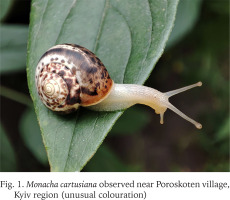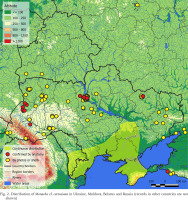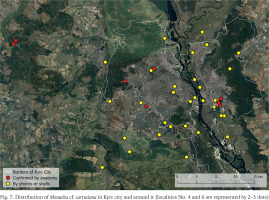INTRODUCTION
In Eastern Europe about 45 species of terrestrial molluscs are known to have extended their natural ranges, which is, in nearly all cases, happening in two directions: from the south to the north and from the west to the east (Sverlova et al. 2006, Son 2010, Balashov 2016, Schikov 2016, Balashov et al. 2018a, b, Gural-Sverlova & Savchuk 2019). Most of these species have started or much intensified extension of their ranges during the last 3 decades, mainly due to the change of climate (Sverlova et al. 2006, Son 2010, Balashov 2016, Balashov et al. 2018a, b). Among these invasive species in Eastern Europe there are 3 species of the genus Monacha (Balashov & Gural-Sverlova 2012, Balashov 2016). Monacha fruticola (Krynicki, 1833) is originated in the Crimea, where its main range is located, and is also distributed across Southern Ukraine (Balashov & Gural-Sverlova 2012, Balashov 2016). Recently new colonies were discovered in Western Ukraine (Gural-Sverlova & Gural 2020a). Monacha cartusiana (O. F. Müller, 1774) is a Mediterranean species distributed also in the regions north from the Black Sea, mostly in Southern Ukraine, including Crimea (Balashov & Gural-Sverlova 2012, Balashov 2016, Gural-Sverlova et al. 2018), and in Moldova (Balashov et al. 2013b). This species has invaded many regions in Central Europe (Kerney et al. 1983, Lesicki & Koralewska-Batura 2007, Peltanová et al. 2012, Welter-Schultes 2012, Pieńkowska et al. 2016, 2018). Several colonies of M. cartusiana were also reported from Western Ukraine (Balashov & Gural-Sverlova 2012, Balashov et al. 2013a, Gural-Sverlova & Savchuk 2019) and only one area was reported from Russia: near Novorosiysk in the coastal part of the Northern Caucasus (Sysoev & Schileyko 2009). Monacha claustralis (Menke, 1828) is native to Southern Europe, while in Eastern Europe it was reported once from Sevastopol city in Crimea (Hausdorf 2000a) and most recently also from Lviv city in Western Ukraine (Gural-Sverlova & Gural 2022). This species has also invaded Poland recently (Pieńkowska et al. 2015, 2016, 2018). M. cartusiana and M. claustralis are very similar species that can be identified only by the structure of the genitalia (Hausdorf 2000a, Pieńkowska et al. 2015) or molecular features (Pieńkowska et al. 2016, 2018, Neiber & Hausdorf 2017), therefore it is problematic to clarify which one of them invaded some area if only photos or empty shells available.
Since early 2020 we have received a large number of reports from the multiple sources about occurrence of the land snails of the subgenus Monacha (M. cf. cartusiana) (Fig. 1) outside their known distribution in Eastern Europe, most often from Central Ukraine. Therefore, the goal of our study was to review expansion of Monacha species in Eastern Europe.
MATERIAL AND METHODS
Anatomical material was examined from 8 areas, for Monacha fruticola: 1) Sofiyska Borshakhivka village near border with Kyiv city, wasteland (former field), 50°24'06.8"N, 30°24'00.6"E, 27.05.2020; 2) Hryshko National Botanical Garden, Pechersk district of Kyiv city, 50°24'28.7"N, 30°33'39.5"E, 10.06.2022; for Monacha cartusiana: 3) Sofiyska Borschahivka village near the border of Kyiv city, along the edges of homesteads, 50°24'12.1"N, 30°23'32.3"E, 28.05.2020; 4) Poroskoten village, Borodyans’kyi district, Kyiv region, around the homesteads, from 50°34'49.6"N, 29°56'44.8"E to 50°34'21.5"N, 29°56'09.6"E, from summer of 2020 to October of 2022; 5) Sviatoshyn ponds, Sviatoshyn district of Kyiv city, grasslands and bushes near ponds, from 50°27'51.9"N, 30°19'30.3"E to 50°27'48.4"N, 30°18'47.7"E, from summer of 2020 to summer of 2021; 6) Vyrlytsia lake, Darnytsia district of Kyiv city, bushes and grasslands along the lake, from 50°24'08.8"N, 30°39'49.2"E to 50°23'16.0"N, 30°39'27.7"E, 05.06.2020; 7) Syretsky Gaj park, Podil district of Kyiv city, bushes and grassland along a railroad, 50°29'08.9"N, 30°26'05.8"E, 23.10.2022; 8) Kulinychi, Kharkiv city, around a pond, 49°59'05.9"N, 36°23'01.6"E, 10.10.2021 (collected by A. Khomenko).
Material from the 8 main studied areas was collected, handled and identified using common methods of work with terrestrial molluscs (Kerney et al. 1983, Balashov 2016) and is kept in the Collection of terrestrial molluscs of I. I. Schmalhausen Institute of Zoology (Kyiv, Ukraine, henceforth in text: IZ). The taxonomy of Monacha proposed by Neiber & Hausdorf (2017) is accepted here. Identification of M. cartusiana by the structure of the genitalia, to exclude M. claustralis and other species of Monacha s.str., was after Hausdorf (2000a) and Pieńkowska et al. (2015).
Secondarily, we also used data from online databases iNaturalist (inaturalist.org) and UkrBIN (ukrbin.com) where photos of molluscs were uploaded by the general public (Appendix 1). We only used those observations from these resources where we were able to confirm or make reliable identification. Accuracy of coordinates for such observations relies on the faithfulness of the users who uploaded them (many of these users are scientists or experienced amateur naturalists, at least most of them are reliable). We have discarded several observations where accuracy of coordinates was suspicious for us for one reason or another.
For the map (Fig. 2) we also used some previously published records in Western and Eastern Ukraine (Balashov et al. 2013a, Gural-Sverlova & Gural 2020b, 2022) and personal communications from N. V. Gural-Sverlova (State Natural History Museum NAS Ukraine, Lviv) regarding her records of M. cartusiana in Western Ukraine, including anatomically checked colonies. The shaded area on the map that shows a relatively continuous distribution of M. cartusiana in the south of Eastern Europe (Fig. 2) is based on previously published data (Balashov 2016, Gural-Sverlova et al. 2018, Gural-Sverlova & Gural 2020b) and, in part, on the data from the IZ collection and iNaturalist.
RESULTS
We have sampled two colonies of Monacha fruticola in and near Kyiv city. These are the first records of this species in Central Ukraine and its northmost known colonies. In Sofiyska Borshakhivka village the snails inhabit an open wasteland that was used as a field until the 2000s; currently neglected, it is an area of about 350 m2, largely covered with bushes. In the middle of the area there are a few empty buildings with remains of a large garden with various trees. M. fruticola snails are common there in the grasslands, bushes and on the edges of a former garden. They are found together with an abundant native snail Caucasotachea vindobonensis (Pfeiffer, 1828), and in some places also with slugs Limax maximus Linnaeus, 1758, Arion fuscus (O. F. Müller, 1774) and Arion fasciatus (Nilsson, 1823). This area is located right next to a large ring road around Kyiv city on its border and is practically part of the megapolis. In the nearby areas along this road there are numerous major commercial centres that selling the building materials, which indicates a potential way of invasion. We have also studied nearby living areas of Sofiyska Borshakhivka, including some where M. cartusiana is living (see below), but M. fruticola was not found there.
In the Hryshko National Botanical Garden (Kyiv) M. fruticola was found notably along the pathways in the area with vegetation from Crimea. Therefore, it is very likely that snails of this colony were delivered directly from the Crimea with plants.
Shells of M. fruticola collected near Kyiv (Fig. 3) are typical for this species (Balashov 2016), their height is 15–17 mm, diameter is 11–13 mm. Genitals (Fig. 5) were checked only in two specimens, one per colony, and they are typical for this species (Balashov 2016): penial retractor is present, vaginal appendix is undivided, flagellum is very long, etc. These snails correspond well with the specimens of M. fruticola from the Crimea that were studied by us.
Figs 3–4
Shells of Monacha species from Ukraine: 3 – Monacha fruticola collected near Kyiv city, No. 1 in “Material and methods”; 4 – Monacha cartusiana collected near Kharkiv city, No. 8 in “Material and methods”; same specimens as in Figs 5–6. Scale bar 5 mm
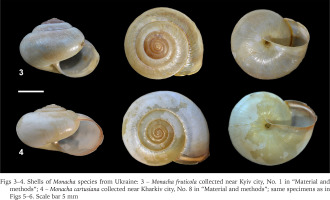
Figs 5–6
Genitalia of Monacha species from Ukraine: 5 – Monacha fruticola collected near Kyiv city; 6 – Monacha cartusiana collected near Kharkiv city; same specimens as in Figs 3–4; bc – bursa copulatrix, f – flagellum, p – penis, va – vaginal appendix, vs – vaginal thickening
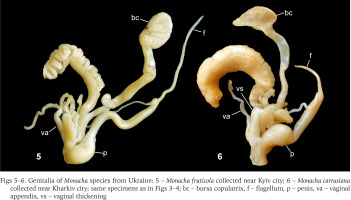
The colonies of M. cartusiana were sampled in 4 areas in Kyiv region and in one area near Kharkiv city (Fig. 4). The latter one, in Kulinychi village, was sampled on 10.10.2021, but there were several reports with photos from this area on iNaturalist starting from 07.08.2014 (see 49 in Appendix 1). In this area, the colony of M. cartusiana is inhabiting some sandy semi-open habitats around a large pond. One specimen from this locality was checked by the structure of genitals (Fig. 6).
From the four areas in Kyiv city we have examined genitals in 5–10 specimens from each colony to exclude M. claustralis and all studied snails are corresponding to M. cartusiana by having more or less developed vaginal thickening (Fig. 6).
In Sofiyska Borshakhivka village M. cartusiana was found on a relatively small area of sideroads along the homesteads, only several tens of meters long. Snails were living along the fences with narrow (1–3 m) belt of grass and bushes along them. In this area M. cartusiana is co-inhabiting with invasive Cepaea nemoralis (Linnaeus, 1758), which was reported by us from this exact locality recently (Balashov & Markova 2021), as well as the native snail Chondrula tridens (O. F. Müller, 1774). The nearby colony of M. fruticola (see above) is living in less than 500 m from this place, but the two species were never found together.
In Poroskoten village M. cartusiana (Fig. 1) inhabits a large area of homesteads that are used mostly as summer houses (“dacha”) covering at least 1 km2. This is a flat area among planted pine forests. Snails are living in private yards with gardens and along the sideroads in grasslands and bushes, also near a large pond, almost continuously. They are especially numerous below the various bushes, most of all lilac (Syringa vulgaris). In 2022 the first of two authors of this paper happened to be in this area from late February to early April. No living snails were seen on the soil surface till 02.04.2022 when after significant rains 4 adult specimens of M. cartusiana were found under the leaves near bushes in a single spot. Temperatures ranged mostly from 0 °C to +10 °C, sometimes up to +18 °C. Most of the snails were still inactive in soil at this time, which was also the case for all other species of mollusc. In this area, M. cartusiana is currently the second commonest species of mollusc following native C. vindobonensis. Other mollusc species that co-occur there with M. cartusiana include Pupilla muscorum (Linnaeus, 1758), C. tridens, Deroceras reticulatum (O. F. Müller, 1774), Deroceras caucasicum (Simroth, 1901), Arion fuscus, Fruticicola fruticum (O. F. Müller, 1774), Helix pomatia Linnaeus, 1758, Trochulus hispidus (Linnaeus, 1758), and Euomphalia strigella (Draparnaud, 1801).
Near Sviatoshyn ponds in Kyiv city M. cartusiana is living in the sandy grasslands and bushes alongside the ponds covering about 300 m2. These habitats are much transformed and other terrestrial molluscs are not numerous in this sandy area, with some C. vindobonensis and H. pomatia present.
Near Vyrlytsia lake in Kyiv city M. cartusiana is living in a belt of sandy grasslands and bushes along the shore, about 1.5 km long. We have studied this area in 2020, but the first record on iNaturalist from there was on 02.09.2017 (see 26 in Appendix 1), which was the earliest known record of any Monacha in Central Ukraine. In this area M. cartusiana is co-occurring mostly with C. vindobonensis. On one small plot here it lives together with an invasive snail Xerolenta obvia (Menke, 1828) (identification by the genitalia).
Near Syretsky Gaj park M. cartusiana was found among the bushes and in grassland right next to a railroad. The species is absent in a nearby forest (park itself) and lives only on its edge along the railroad. The invasive slugs Krynickillus melanocephalus Kaleniczenko, 1851 and Deroceras reticulatum were found in the same place.
The data collected by us together with the data from other sources (see Appendix 1) was used to create a map showing distribution of M. cf. cartusiana in Ukraine and some neighboring countries (Fig. 2) and more detailed map showing wide expansion of M. cf. cartusiana in Kyiv city and around it (Fig. 7).
DISCUSSION
Present findings of M. fruticola in Central Ukraine are making identification of the local molluscs to be more problematic. The shell in this species is very similar to that in the common native species Fruticicola fruticum. Although in M. fruticola the shell is usually smaller, less globular and with narrower umbilicus, the variability of these characters causes overlap with those in F. fruticum (Balashov 2016). The two species can be reliably distinguished by the presence of the microscopic spiral sculpture on the shell’s surface in F. fruticum (Balashov 2016), but it cannot usually be seen by eye or on the regular photographs. Consequently, it will be often impossible, or at least much more difficult, to distinguish M. fruticola and F. fruticum in the field.
Present data (Fig. 2) shows a wide expansion of Monacha species outside their previously known ranges in Eastern Europe with M. cartusiana becoming very abundant in some areas. Considering that molluscs of these newly-occupied regions were relatively well-studied (Sverlova et al. 2006, Sysoev & Schileyko 2009, Balashov & Gural-Sverlova 2012, Balashov 2016, Schikov 2016, Gural-Sverlova & Gural 2020b, etc.) it can be assumed that at least most of the expansion into Central, Northern and north-eastern Ukraine, as well as into Belarus and western regions of Russia, has happened during the last decade (in contrast to the previously known distribution in Southern Ukraine and Caucasus). It is even more evident on the smaller scale for Kyiv city and adjacent areas (Fig. 7) where terrestrial molluscs were studied repeatedly for a long time (Jelski 1863, Baidashnikov 1992, Tappert et al. 2001, Sverlova et al. 2006, Balashov 2016, etc.), but Monacha species were never found before 2017. We have reported here 36 colonies of M. cf. cartusiana in Kyiv region with some of them being very abundant and covering several tens of hectares each. We often visited and searched for molluscs in some of these areas in 2000s and 2010s, but no Monacha was found there. Therefore, there is no doubt that expansion of Monacha in Kyiv region has happened mostly during the last few years.
Considering that all our specimens of Monacha s. str. from Central and north-eastern Ukraine that were identified by the structure of the genitalia are M. cartusiana, it suggests that at least most of the new records (Fig. 2) represent this species. It is even more likely for all colonies in Kyiv region (Fig. 7) where we have examined genitals in over 35 specimens from 5 areas. Although, considering that M. cartusiana and M. claustralis are both present in Western Ukraine and Poland, where they sometimes co-occur (Pieńkowska et al. 2016, 2018), it cannot be ruled out that some of our records refer to M. claustralis.
In its new area of distribution in Eastern Europe (Fig. 2) M. cartusiana is mostly living in the sandy habitats, often around ponds or lakes. Some of these habitats are semi-natural and situated outside settlements. In Kyiv city and around it M. cartusiana forms large continuous colonies that cover many square hectares or maybe even square kilometers (Fig. 7). It especially applies to the areas on the left (east) bank of the Dnipro River where we have studied only one area around Vyrlytsia lake, but there are several other findings near neighboring lakes and elsewhere (Fig. 7). Perhaps all these records represent one huge continuous colony. It could be the case also for some other series of records on the right (west) bank of the Dnipro River around Kyiv (Fig. 7). Therefore, M. cartusiana is currently not depending on the anthropogenic environment outside its native range in Eastern Europe. Apparently, such situation is mostly a result of the climate change. In Southern Ukraine, where species is known to occur for at least 140 years, M. cartusiana is also living largely in the coastal sandy habitats, mostly in more or less transformed by human activity. In the southern Crimea M. cartusiana is absent in the dry coastal habitats with complex native communities, such as the sparse forests of Greek juniper (Balashov & Baidashnikov 2013), instead it is mostly associated with the anthropogenic coastal habitats (Balashov 2016). There are no fossil records of Monacha from Pleistocene or Holocene of Ukraine (Kunitsa 2007, Balashov 2016). It all suggests that expansion of Monacha species on the plains of present-day Southern Ukraine has happened rather recently, perhaps in the Holocene, in response to the natural change of climate after the last glacial. Perhaps it is even happened in the historic time with assistance from humans, as it was shown for an old invasion of Helix lucorum Linnaeus, 1758 in the Crimea from Anatolia (Korábek et al. 2018). In such a case, M. cartusiana could be a non-indigenous species for all parts of Eastern Europe, including the Crimea.
It appears that the genus Monacha originated mainly in Anatolia with several species being endemic to Caucasus, Balkans and other southern regions of Europe, including one Crimean species (Hausdorf 2000a, b, Irikov 2008, Neiber & Hausdorf 2017). A few species of Monacha have naturally colonised most of Western and Central Europe, while M. cartusiana and M. fruticola represent expansion of this genus in a northeastern direction.
As with M. cartusiana, the presence of M. fruticola on the plains in southern regions of Eastern Europe is the product of a relatively recent expansion. The role of human activity in this expansion is uncertain. We note that the main range of M. fruticola is placed in the Crimean Mountains (Neiber & Hausdorf 2017), much closer to those regions than that of M. cartusiana. There are two other species of land snails of the Crimean origin that colonized plains of Southern Ukraine outside Crimea: Helicopsis filimargo (Krynicki, 1833) (Balashov et al. 2021) and Brephulopsis cylindrica (Menke, 1828) (Balashov et al. 2018). The borders of the natural ranges in these species, especially B. cylindrica, are uncertain, same as in M. fruticola.
Aided directly or not, it appears that current invasion of two Monacha species into the central part of Eastern Europe is a response to the anthropogenic change of climate that in some way represents a continuation of the natural processes associated with changes of climate following the last glacial. With further warming of climate the Monacha species, first of all M. cartusiana, are expected to become widespread and common in Eastern Europe.

